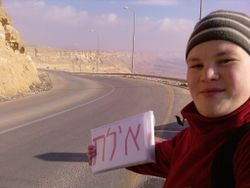Israel
| Information | |
| Language: | Hebrew (official), Arabic (official), Russian and English most commonly used foreign languages |
| Capital: | Jerusalem |
| Population: | 7,900,117 (2008 est.) |
| Currency: | New Israeli Sheqel (NIS) |
| Hitchability: | |
| More info: | AVP Free Encyclopedia (Russian) |
| Meet fellow hitchhikers on Trustroots | |
Hitchhiking is very common in Israel. Hitchhiking is often done by pointing to the ground with the hand far from the body, instead of raising a thumb. But possibly raising a thumb will be understood as well. Hitchhiking in Israel is usually done without a sign, since stopping in almost all junctions is possible. An exception for this is the new Road 6, in which stopping in only possible on on-ramps and petrol stations.
The most usual way to start an hitchhiking journey is to take a bus out of town, to a junction in your direction. Almost every junction has a hitchhiking spot (the famous Trempiyada), or at least a bus station where drivers can stop. In some places, like Tel Aviv, it's very hard to hitchhike from the city, and inter-urban buses are relatively cheap and can get you to the nearest junction. However, in Jerusalem it is possible to hitchhike to the suburbs from within the city, a practice used extensivly among religious Jewish kids.
Safety
Like always, precaution is needed when hitchhiking, although in Israel hitchhiking is a way of life. You will find hitchhikers everywhere. Even still, caution is necessary.
You should remember that as a country in a sub-tropical region, it can get very hot in Israel, sometimes as early as March and as late as September. If you can, before hitchhiking check the predicted weather in the region of your travel, and if it's going to be hot, don't ignore it. Exposing yourself to heat without caution can be dangerous. In hot days, wear a hat and drink a lot of fluids, especially if hitchhiking in the desert. Suncream and sunglasses are also recommended.
Cities and locations
See also
Shabbath
In Israel people work on Sundays so you'll be fine, but Shabbath is a horrible 24 hours for hitchhiking there since religious people are not driving at all (and they're usually quite skilled at picking up hitchhikers). Note that Shabbath starts on Friday when the Sun sets and ends on the Sun set on Saturday.
Crossing borders
Note: Israel shares borders with these countries; however, due to hostile relations between the states, it is illegal and probably impossible to cross over to Syria or Lebanon; Getting into Palestinian territory in the West Bank is quite straight forward, usually flashing your passport in the checkpoint is enough. Getting to Gaza should be problematic. Egypt and Jordan should be fine.
To Egypt
After Israeli forces closed down the Rafah border crossing, Taba is the only border crossing for passengers from Israel to Egypt. It is situated 5km south of Eilat, and is accessible by public transport from both directions. There are almost no cars passing the border, everyone does it by foot. Notice that if you plan to continue after Sinai, to Cairo for instance, you most likely need an Egyptian visa which is obtainable in the embassy in Tel Aviv or in Eilat. Bring with you 4 passport photos, 100 NIS and a photocopy of your passport. It takes around 4 hours for Western citizens.
To Syria and Lebanon
Not possible. You can't enter Syria or Lebanon coming from Israel (or with a passport that shows that you've been in Israel, even with just a stamp from a border crossing to Egypt or Jordan). It is also not possible to enter these countries and other Arab countries which have no diplomatic relations with Israel, if you have an Israeli stamp in your passport.
Avoiding an Israeli stamp
When entering Israel at Ben Gurion it's okay to ask the border people to not stamp your passport. However, this only makes sense if you fly in from Egypt, since if you go to the Syrian border from Jordan with a passport not showing how you entered the Middle East, they will simply refuse your passport.
At the Jordan crossings officials on both sides generally seem to not stamp your passport if you ask them to.
Egyptians generally always stamp.
To Jordan
Israel currently run 3 border terminals with Jordan:
- In northern Israel, next to Beit Sheaan, you can cross in the Abdallah bridge crossing, from which it is quite straight forward if you continue onwards to Amman.
- In Palestine (the occupied territories) the Israeli forces run the Allenby bridge crossing, seperating Jordan from the Palestinian territories. Because of its location, this border is only crossable to Palestinians and internationals (not Israelis) and the passengers are subject to intimdating "security" interrogations. This is also the most direct border crossing from Amman to Jerusalem. Notice that if you need a Jordanian visa, it cannot be acquired at this crossing.
- In the south, 3km north of Eilat, you can cross at the Arava crossing (Yitzchak Rabin terminal) which seperates Eilat from Aqaba. This is probably the most popular border terminal.
